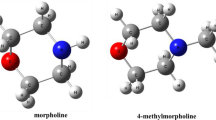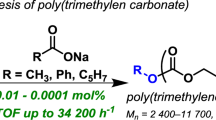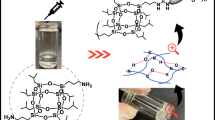Abstract
The polymer of isocyanic acid has been referred to as cyamelide (cyamelid) by Liebig and Wöhler in some early studies, in which it was considered a mixture of chain polymers of isocyanic acid and cyanuric acid. Despite the knowledge of its fundamental structure, the chain polymeric compound has not been well characterized. We herein polymerized isocyanic acid and purified the resultant polymer to obtain a white powder. This powder was characterized by using IR, Raman, and UV spectroscopies; X-ray diffraction analysis; and band calculations. Analogous to the extended systems of urea, e.g., biuret, triuret, and higher oligomers, we refer to this polymer as polyuret. The structural chemistry of the polyuret was thoroughly explored with regard to possible cis/trans-isomerism. This polymer has flat bands at the frontier levels due to the nonbonding character of the urea moieties. We suggest that this compound should no longer be referred to as cyamelide or polyisocyanate to avoid confusion with the aforementioned uncharacterized mixture or with isocyanate-pendant polymers.
This is a preview of subscription content, access via your institution
Access options
Subscribe to this journal
Receive 12 print issues and online access
$259.00 per year
only $21.58 per issue
Buy this article
- Purchase on Springer Link
- Instant access to full article PDF
Prices may be subject to local taxes which are calculated during checkout









Similar content being viewed by others
References
Iwamura H. High-spin organic molecules and spin alignment in organic molecular assemblies. Adv Phys Org Chem. 1990;26:179–253.
Rajca A. The physical organic chemistry of very high-spin polyradicals. Adv Phys Org Chem. 2005;40:153–99.
Vicencio RA, Cantillano C, M-Inostroza L, Real B, Mejía-Cortés C, Weimann S, et al. Observation of localized states in Lieb photonic lattices. Phys Rev Lett. 2015;114:245503.
Mukherjee S, Spracklen A, Choudhury D, Goldman N, Öhberg P, Andersson E, et al. Observation of a localized flat-band state in a photonic Lieb lattice. Phys Rev Lett. 2015;114:245504.
Morales-Inostroza L, Vicencio RA. Simple method to construct flat-band lattices. Phys Rev A. 2016;94:043831.
Alberola A, Less RJ, Pask CM, Rawson JM, Palacio F, Oliete P, et al. A Thiazyl-based organic ferromagnet. Angew Chem Int Ed. 2003;42:4782–5.
Hatanaka M. Tautomerism in polyguanide. Comput Theor Chem. 2011;971:58–64.
Dowd P. Trimethylenemethane. Acc Chem Res. 1972;5:242–8.
Hatanaka M, Shiba R. Prediction of high-spin ground states of biguanide trication and biuret trication as a design for novel polymer ferrromagnets. J Comp Chem Jpn. 2005;4:101–6.
Hatanaka M. High-spin stability of urea dication. Comp Theor Chem. 2011;968:44–8.
Liebig J, Wöhler F. Untersuchungen über die Cyansäure. Ann Phys Chem 1830;20:369–400.
Lehmann MA. Hantzsch: Ueber das Cyamelid. Berichte; 1905:1013–21.
Senier A, Walsh T. The polymerization of cyanic acid: cyanuric acid, and cyamelide. J Chem Soc. 1908;81:290–1.
Geith J, Klapötke TM. Ab initio calculations of the polymerization pathways of isocyanic acid HNCO. J Mol Struct (Theochem). 2001;538:29–39.
Carlström D, Ringertz H. The molecular and crystal structure of triuret. Acta Cryst. 1965;18:307–13.
Roth J, O’Leary DJ, Wade CG, Miller D, Armstrong KB, Thoburn JD. Conformational analysis of alkylated biuret and triuret: evidence for helicity and helical inversion in oligoisocyanates. Org Lett. 2000;2:3063–66.
Ni Y, Becquart F, Chen J, Taha M. Polyurea–urethane supramolecular thermo-reversible networks. Macromolecules. 2013;46:1066–74.
Freeman HC, Smith JEWL, Taylor JC. Crystallographic studies of the biuret reaction. Nature. 1959;184:707–10.
Kurzer F. Biuret and related compounds. Chem Rev. 1956;95–197.
Bur AJ, Fetters LJ. The chain structure, polymerization, and conformation of polyisocyanates. Chem Rev. 1976;76:727–46.
Mayer S, Zentel R. Chiral polyisocyanates, a special class of helical polymers. Prog Polym Sci. 2001;26:1973–2013.
Hoover FW, Stevenson HB, Rothrock HS. Chemistry of isocyanic acid I. Reactions of isocyanic acid with carbonyl compounds. J Org Chem. 1963;28:1825–30.
Hamada H, Iwai T, Hayashi K, Okamura S. Radiation induced polymerization of isocyanic acid. Kobunshi Kagaku. 1965;22:639–45.
Chen J, Zhao P, Liu Y, Liu H, Zhu F. Clean and facile synthesis of triuret from urea and dimethyl carbonate (DMC) under mild conditions. Korean J Chem Eng. 2012;29:288–90.
Hoffmann R. An extended Hückel theory I. Hydrocarbons. J Phys Chem. 1963;39:1397–412.
Stewart JJP. Optimization of parameters for semiempirical methods VI: more modifications to the NDDO approximations and re-optimization of parameters. J Mol Model. 2013;19:1–32.
te Velde G, Baerends EJ. Phys Rev B. 1991;44:7888–903.
Philipsen PHT, te Velde G, Baerends EJ, Berger JA, de Boeij PL, Franchini M, et al. BAND 2019.3, SCM, Theoretical chemistry. Amsterdam: Vrije Universiteit. 2019. http://www.scm.com.
Altomare A, Cuocci C, Giacovazzo C, Moliterni A, Rizzi R, Corriero N, et al. EXPO2013: a kit of tools for phasing crystal structures from powder data. J Appl Cryst. 2013;46:1231–5.
Shirakawa H, Ikeda S. Infrared spectra of poly(acetylene). Polym J. 1971;2:231–44.
Borden WT, Davidson ER. Effects of electron repulsion in conjugated hydrocarbon diradicals. J Am Chem Soc. 1977;99:4587–94.
Hatanaka M. Stability criterion for organic ferromagnetism. Theor Chem Acc. 2011;129:151–60.
Becke AD. Density-functional exchange-energy approximation with correct asymptotic behavior. Phys Rev A. 1988;38:3098–100.
Lee C, Yang W, Parr RG. Development of the Colle-Salvetti correlation-energy formula into a functional of the electron density. Phys Rev B. 1988;37:785–9.
Fukui K, Morokuma K, Yonezawa T, Nagata C. A further study of simple LCAO MO perturbation treatment of conjugated molecules. Bull Chem Soc Jpn. 1960;33:963–73.
Perdew JP. Density-functional approximation for the correlation energy of the inhomogeneous electron gas. Phys Rev B. 1986;33:8822–4.
Gu J, Wu W, Stuyver T, Danovich D, Hoffmann R, Tsuji Y, et al. Cross conjugation in polymers and related hydrocarbons: What can be learned from valence bond theory about single-molecule conductance? J Am Chem Soc. 2019;141:6030–47.
Haworth RC, Mann FG. Some properties of urea, biuret, and triuret. J Chem Soc. 1943;603–6.
Trinquier G, Suaud N, Guihéry N, Malrieu J-P. Designing magnetic organic lattices from high-spin polycyclic units. ChemPhysChem. 2011;12:3020–36.
Hatanaka. M. Role of topological charge stabilization in protomeric tautomerism. J Phys Chem A. 2015;119:1074–86.
Acknowledgements
This work was supported by JSPS KAKENHI Grant Number JP19K05392.
Author information
Authors and Affiliations
Corresponding author
Ethics declarations
Conflict of interest
The authors declare that they have no conflict of interest.
Additional information
Publisher’s note Springer Nature remains neutral with regard to jurisdictional claims in published maps and institutional affiliations.
Rights and permissions
About this article
Cite this article
Liu, Y., Hatanaka, M. & Miyasaka, M. Structural aspects and electronic states of polyuret—construction of robust extended systems with nonbonding flat bands. Polym J 52, 1067–1076 (2020). https://doi.org/10.1038/s41428-020-0349-2
Received:
Revised:
Accepted:
Published:
Issue Date:
DOI: https://doi.org/10.1038/s41428-020-0349-2



